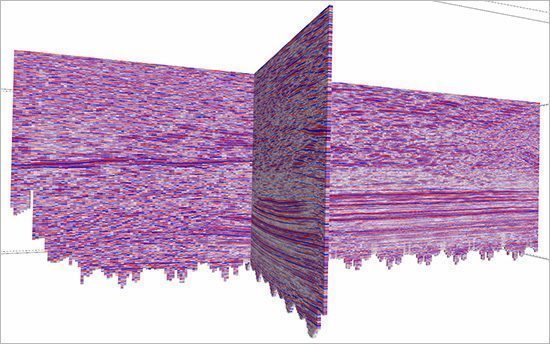Isatis manages several million data sets
Posted on Through the years, Geovariances has always endeavored to improve Isatis performances to answer their client constraints related to the always increasing size of their data sets. Most of the algorithms in Isatis are thus optimized and parallelized to run on multi-threaded computers and decrease computation time in a significant manner.

This is true for the interpolation, simulation, and kriging algorithms, for the Automatic Variogram Fitting application, for tools allowing operations between files (Migrate, Copy Statistics), for specific tools such as Grid Filling, Multi-Acquisition Factorial Kriging or Image Filtering & Deconvolution, for Selection tools, for the 3D Viewer which enables a decimation process when displaying data.
When data are dense, it is also possible to reduce the number of input data without compromising output result quality. This can be performed in several ways in Isatis. Refer to the How-To Flier “How to compute quickly a reliable trend with Isatis” for more details:
- By selecting data on a regular grid using Sampling Selection or Migrate tools;
- Or using the Look for Duplicates tool.
It is then necessary to control the estimation variance on a test zone to be sure that there is no loss in the estimate quality.
At last, another way of improving performance is to reduce the number of variables if you are dealing with many attributes. Isatis makes it easy with applications such as Principal Component Analysis or Min/Max Autocorrelation Factors.
More recently, Geovariances added new tools in Isatis called Split/Merge Data. These new applications have been developed in order to help with processing large Grid Files to deal with seismic data. Split Data cut the input grid in as many sub-grids as you wish and further computations are performed for each sub-grid independently, thus dividing the computation time. Merge Data allows then to regroup the results computed on the previous separate sub-grids under a unique larger grid file. See Isatis 2015 release notes.
To conclude, reducing datasets is not the only way to gain time. You can also use the scripting procedures Isatis offers to automate workflows.
Mining (14)
Nuclear Decommissioning (9)
Contaminated sites (7)
Oil & Gas (6)
Hydrogeology (5)
TAGS:
2D/3D (2)
Background images (1)
Big data (1)
Conditional simulations (7)
Contaminated sites (2)
Contamination (2)
Drill Hole Spacing Analysis DHSA (3)
Excavation (2)
Facies modeling (2)
Flow modeling (1)
Geological modeling (3)
Gestion des sites pollués (2)
H2020 INSIDER (1)
Horizon mapping (1)
Ice content evaluation (1)
Isatis (11)
Isatis.neo (16)
Kartotrak (8)
Machine Learning (2)
Mapping (3)
MIK (2)
Mineral resource estimation (7)
Monitoring network optimization (1)
MPS (2)
Ore Control (1)
Pareto (2)
Pollution (2)
Post-accidental situation (2)
Recoverable resource estimation (3)
Resource classification (2)
Resources workflow (1)
Resource workflow (3)
Risk analysis (3)
Sample clustering (1)
Sampling optimization (3)
Scripting procedures (3)
Simulation post-processing (1)
Site characterization (2)
Soil contamination mapping (4)
Time-to-Depth conversion (1)
Uncertainty analysis (2)
Uniform Conditioning (5)
Variography (2)
Volumes (2)
Water quality modeling (1)
AUTHORS:
David Barry (3)
Yvon Desnoyers (2)
Pedram Masoudi (2)
Catherine BLEINES (1)
Pedro Correia (1)
DATES:
2023 (2)
2022 (3)
2021 (2)
2020 (2)
2019 (8)
2018 (4)
2017 (3)
2016 (3)